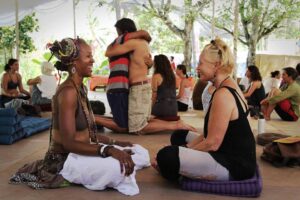TONGLEN – BREATHING TO CULTIVATE COMPASSION
Tonglen is a Tibetan Buddhist meditation practice that derives from the Tibetan word for ‘giving and taking’ or ‘sending and receiving’.
Often in breath practice we are asked to draw in what we need from the inhale, both biologically and emotionally, and to release what we do not want or need in the exhale.

To some extent, the concept of tonglen reverses this. In tonglen, you breathe in the suffering, you breathe in all that is painful or negative.
Drawing the negative closer to yourself may seem counter-intuitive in breathwork. Why would we want to imagine breathing in the ‘dirty’ energy as opposed to taking a breath of fresh air? We are accustomed to pushing pain and suffering away, but if we are able to face it, to breathe it in, we are acknowledging and accepting its existence. Spending even a moment breathing in a feeling of discomfort may help us to lose our fear of it.

Some advocates of tonglen suggest that we envisage the negative energy as a cloud around us or a curling black smoke. After drawing this into ourselves, we allow the compassionate alchemy of the heart and mind to transform the energy – from pain to relief, from twisting darkness to radiant light, from dirty smoke to clean air, from claustrophobia to expansiveness. The Tibetan Book of Living and Dying suggests that we may visualise ourselves as two people – the hurt or angry self and the loving, compassionate self. On the in-breath the hurt self is drawn close into the vast compassionate embrace of the loving self. On the out-breath the hurt dissolves into the loving self’s embrace.

Pema Chodron translates the word tonglen as ‘exchanging oneself for others’. Though we may begin by practising compassion for ourselves, we can also expand our compassion to breathe in the suffering of others and send out a wish for their healing. This may be someone we know and love. Or someone we know and find difficult to love. Or a stranger suffering in front of us. Or a group of people suffering somewhere far, far away. We can always expand our circle of compassion further, and in doing so, expand not only our lungs, but our hearts.





